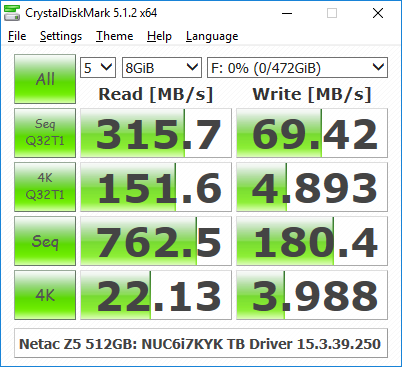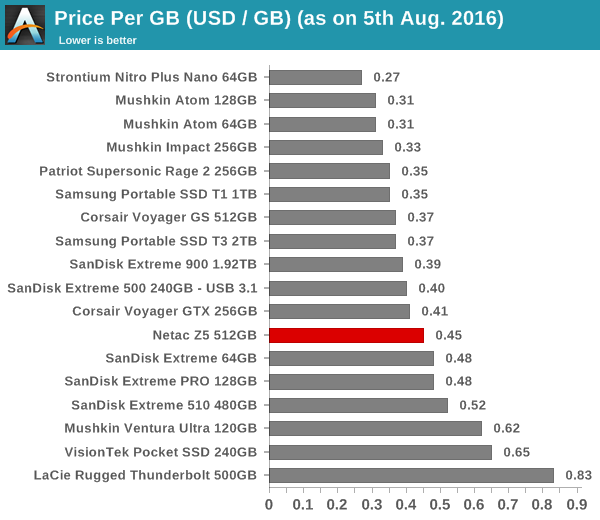Netac Z5 USB 3.1 Gen 2 Portable SSD Review
by Ganesh T S on August 9, 2016 8:00 AM ESTMiscellaneous Aspects
One of the major pain points associated with USB 3.1 Gen 2 SSDs (such as the SanDisk Extreme 900 and the Netac Z5 being evaluated today) is performance consistency across different host systems. There are two popular USB 3.1 Gen 2 bridge chips used by systems and boards currently in the market - the ASMedia ASM1142 and the Intel Alpine Ridge. The driver scenarios for both are quite tricky, depending on the vendor of the board / card / system. ASMedia's custom drivers for ASM1142 are no longer needed, given that Windows 10 bundles a Microsoft USB 3.1 xHCI driver. In the case of Alpine Ridge, even though the Microsoft xHCI drivers are utilized, the Thunderbolt driver version also plays a major role in the performance.
We evaluated the performance of the Netac Z5 across a host of different systems using multiple driver versions.

As one can see from the CrystalDiskMark numbers, the performance is heavily dependent on the drivers being used. In multiple cases, we found that writes wouldn't go above 100 MBps. To confound matters further, the ASMedia ASM1142-equipped systems sometimes performed worse with newer driver versions. It is always good to ensure that the proper drivers (as suggested by the vendor) are utilized when it comes to getting the maximum performance out of USB 3.1 Gen 2 devices such as the Netac Z5.
Pricing and Availability
The Netac Z5 is currently available in the retail market only in China. While trying to look up the pricing information, we chanced upon a Chinese e-tailer listing for the unit at ¥1509.00 (approximately USD 228).

The device most similar to the Netac Z5 that we have evaluated before is the SanDisk Extreme 900 1.92TB Portable SSD. On a $/GB basis, the Netac Z5 is priced higher compared to that. However, when considering similar capacities, the Extreme 900 480GB retails for $300, while the Netac Z5 512GB is priced at $228. This is a considerable price difference in favor of the Netac Z5. The prospect of lowered prices for USB 3.1 Gen 2 client devices is sure to drive mass adoption of the technology.
Final Words
The number of client devices that can take advantage of the full capabilities of USB 3.1 Gen 2 are few in number. Coming to the business end of the review, we are pleased to have evaluated one of those devices and be able to compare its performance to the SanDisk Extreme 900 that we reviewed earlier. The Z5 is a bit more compact compared to the SanDisk Extreme 900. The industrial design is also much more pleasing. However, in terms of power consumption (for idle and sustained loading conditions), the SanDisk Extreme 900 1.92TB version seems to fare better compared to the Netac Z5 512GB that we have reviewed today. The drivers in the host system also play a major role in the user-experience, but, Netac doesn't have control over that aspect.
Our concerns about the Netac Z5 are the typical ones we have for external SSDs - the absence of TRIM support over the ASMedia ASM1352R bridge chip, and a guarantee on the type of flash (MLC or TLC) that would be used across all the production units. Both of these have an effect on the long-term performance consistency of the product. External SSD vendors do not provide any workload ratings, and we can't fault Netac for not doing it either. That said, Netac does provide a 3-year warranty for the Z5. Our main suggestions for Netac would be to implement TRIM support and guarantee MLC flash (or, at the least, be upfront about what will be used in the units sold to consumers).
Usual concerns aside, the Netac Z5 is amongst the top performers when it comes to bus-powered direct-attached storage devices. Currently, putting two SATA SSDs in RAID-0 seems to be the most cost-effective way of getting a USB 3.1 Gen 2 storage device to the market. Netac has adopted the same strategy with the Z5. It has also managed to heavily undercut the price of the only other similar device in the market (the 480GB SanDisk Extreme 900). The Netac Z5 is a welcome addition to the family of USB 3.1 Gen 2 devices in the market, and we look forward to Netac adopting a wider distribution strategy for the product.











22 Comments
View All Comments
Chaitanya - Tuesday, August 9, 2016 - link
Those seq. writes are nothing special.ganeshts - Tuesday, August 9, 2016 - link
With the right system and drivers, you can hit upwards of 600 MBps for real-world workloads. At this price point, I don't think there is a better performer. The SanDisk Extreme 900 also performs similarly.Flunk - Tuesday, August 9, 2016 - link
At about $228, it's forgivable.osxandwindows - Tuesday, August 9, 2016 - link
Thats the same performance of a thunderbolt 1 ssd.R0H1T - Tuesday, August 9, 2016 - link
This thing's hot, quite literally, & not in a good way.WorldWithoutMadness - Tuesday, August 9, 2016 - link
and sooner or later we'll confront data loss because of bga solder fatigueganeshts - Tuesday, August 9, 2016 - link
No doubt the unit could do with better thermal design, but, transferring upwards of 250GB of data within a short time duration (that causes temperature of the metal case to reach 46C) is, I would imagine, not a frequent use-case.Netac is already aware of the need for a better thermal solution.
cygnus1 - Tuesday, August 9, 2016 - link
Yeah, I think if they just added a thermal pad that would let the heat transfer away to the case from the pertinent chops quicker than through the PCB and open air to the case would go a long way in keeping the device cooler overall.kaidenshi - Tuesday, August 9, 2016 - link
I did that with a 2.5" external spinning HDD that was getting too hot; put a thermal pad between its base and the metal USB 3.0 case. That kept it about 15C cooler than the cloth pad(!) they had glued in there, and kept vibrations down as well.Samus - Tuesday, August 9, 2016 - link
A common misconception with mSATA SSD's is their thermal profile.They run incredibly hot. My Samsung 840 mSATA SSD idles at 47 degrees C with a load temp in the low 60's.
It's been this way for years and hasn't failed. Samsung, Lite On and Micron all rate their OEM SSD's at a working temp of 0-75C. Yes, 75 Celsius is actually within design specifications!
A lot of it has to do with the PCB. The shape of the mSATA SSD, in addition to it operating at a higher voltage than m2, create a less efficient therma design. But that doesn't make it unreliable, just unusual as far as why we consider the 'norm' for storage temperatures which have historically considered 30-40C to be ideal.
But interestingly even Backblaze has shown in their reliability survey (which I have always found unrealistic because it only considers cold storage applications) that 'high' hard disk temperatures have little correlation to reliability even when approaching 50C. In fact it is low temperatures, below 30C, that have a connection to disk failure. Not unreasonable evidence when you think about the thermal dynamics of spinning metal disks; metals wears less at higher temperatures...bearings, motors, etc.
I understand SSD's are entirely different physics and there is no ideal operating temperature, or rather it is a significantly wider range, but really the only temperature concern with NAND is during cold storage where 20-25C is substantially more ideal than above 30C.